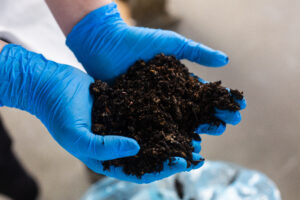Local Food Networks and D2C Food Business: Key Takeaways from a Panel Discussion with GrubMarket, Imperfect Foods, and G2VP
During the latest Power Breakfast co-hosted with Silicon Valley Bank and Wilson Sonsini Goodrich & Rosati, I sat down with Mike Xu (CEO, GrubMarket), Aleks Strub (CMO, Imperfect Foods) and Brook Porter (Founding Partner, G2VP) to talk about growing local food networks and the challenges of building direct-to-consumer businesses in the food industry. Here are some key takeaways:

Local is a proxy for transparency. Consumers see local as more important than organic, fresh, or other premium labels, and are willing to pay for it. Local implies trust, traceability, reduced food miles, and increased quality even when these benefits are assumed rather than real.
Local is not necessarily more green or efficient. Logistics costs are a function of volume, weight, and distance. A container of apples from 1,000 miles away may cost less per unit to ship than a crate of locally grown Red Delicious. Distance is often not the main factor in logistics costs.
D2C is just one model helping to improve the food chain. But it is the hardest to acquire customers in. D2C wins when companies manage to teach people to care about the origin of their products. It is still in development. Less than 2% of food is purchased online but the market is growing so fast Nielsen has had to update its online retail figures.
If this is just a logistics challenge, then Amazon should be crushing start-ups. This is a food chain challenge. The task for a company like Imperfect Foods is to provide a unique experience to the customer, especially as food is such a personal item to buy. This is why the company has taken control of their own delivery. Imperfect gets two chances to interact with its customer – at sale and at delivery – and so it needs to be able to control the experience in both situations.
Food is not unique to e-commerce, but it is certainly more complex than other categories. There are many ways it is being sold online and no one has discovered a silver bullet. Even Amazon is winding down some Amazon Fresh operations, including a sustainable packaging initiative they failed to make profitable. Food and ag. giants are still experimenting with online, home delivery, and automation solutions.
There is space for two or three Amazons in the food industry. While reports show that only 2% of food is bought online, GrubMarket CEO Mike Xu believes the number could be much, much lower; under 1%. He believes the difference will be made when a logistics company looks only at food. Amazon has not dominated with Amazon Fresh because they are another logistics player optimized to deliver anywhere at speed and in volume, not deliver from local suppliers while still fresh.
The food chain is automating fast at the consumer end and slower in the middle. Logistics software, freight and routing management are already there to optimize delivery schedules. Instacart exists to provide convenience and hassle-free shopping, even if the panelists cast doubts over its business model as substitution rather than innovation. The pavement robots are ready, and so perhaps five years until they are widespread, and another five years until they are adopted in food giants’ supply chains.
Upstream, things are still looking very analogue. As food is one of the last industries to digitize, there is still plenty of pen & paper, phone & fax-based systems in the food chain. Innovation in automating steps in the supply chain like quality inspection (ImpactVision), safety testing (Clear Labs) and many other steps are still at the Series A/B stage. It is essentially still an analogue system that is optimized for logistic efficiency, not for freshness. In reaction to this, GrubMarket, which has a strong B2B wholesale platform to complement its B2C platform, is looking to sell a software integration tool for supply chain players.
Waste not, want not. A lesson from the salmon industry
Aleks from Imperfect Foods used the great example of a sustainable salmon farmer from Norway. The farmer supplied many retailers across the globe with 4oz. salmon fillets. However, because salmon do not grow in perfect 4oz. fillets, the supplier had many 3oz. and 5oz. fillets going to waste. Imperfect Foods can bundle these into 1lb packets and sell for $9.50/lb, where the 4oz. fillets in the supermarket may cost you twice or three times that.
In the next ten years you will see:
- More fresh goods in local grocery stores
- Changing balance between centre and periphery of store to favor fresh produce
- Virtual local grocery stores with pick-up facilities
- Stores modifying to enable delivery/pick-up/in-store shopping alternatives
- Less packaging
- Increasing automation in warehousing
- Robots on the pavement.
Given the gavel, the panelists would make key regulation changes in the industry:
- Under current SNAP (Supplemental Nutrition Assistance Program) legislation, you cannot use food stamps to buy food online. Imperfect Foods runs a food access program with Kroger selling boxes of food at one-third of cost, but low-income families still cannot buy them online as they don’t have the cash to do so and cannot use food stamps. SNAP should be adapted to allow for online use and give low-income families access to the growing number of online food delivery options.
- Getting certified as an organic farmer costs $5,000 in California. Making organic certification more affordable will allow smaller farmers and producers to add premium value to their products.
Keep an eye on… first-mile drone logistics. Much energy and investment has gone into solving last-mile logistics in the form of software tools or drone-based pizza delivery. However, optimizing a local food system collection of produce is often as, if not more, complex. Drone-based delivery of produce from remote farms to a centralized location may prove to be a more lucrative use of drone and automation technology.
Looking for more insight into how food delivery, supply chains and how we can use new technology and business models to limit wastage? Join our session, Food Loss: How Can Innovation Solve This $300 Billion Problem?, at Cleantech Forum San Francisco on 27-29 January.


